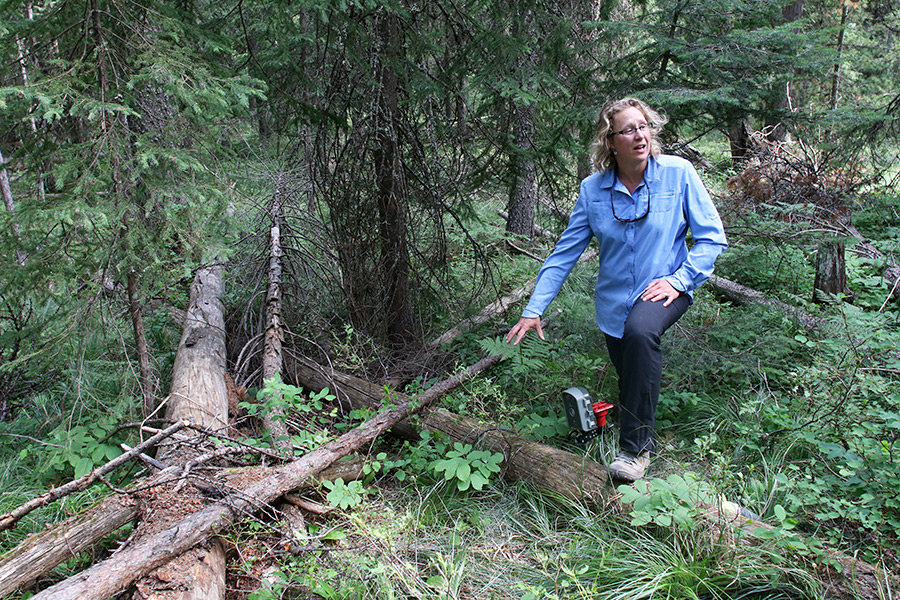WEST GLACIER – For Tabitha Graves, the ability to presage a bumper crop of huckleberries – or, conversely, a dearth of the delicious fruit – carries far greater implications than merely filling up jam jars or homing in on a secret picking patch.
Graves, a research ecologist with the U.S. Geological Survey’s Northern Rocky Mountain Science Center in Glacier National Park, is in the second year of a pilot program aimed at tracking the timing and productivity of huckleberry patches, which this sultry summer are bearing little fruit at lower elevations.
She won’t hazard a guess about the overall upshot of this season’s crop, though of the five monitoring sites she’s able to compare to last year’s data, only one is on par with the previous summer, which sprayed a veritable star-scape of the dark-red berries throughout the forests that hug the Continental Divide.
Wild huckleberries grow in droves on both sides of the Continental Divide, their tart flavor sought out by humans and grizzly bears alike. And while visitors to Glacier can pick one quart of huckleberries per person per day for personal consumption only (Waterton Lakes National Park only allows hand-to-mouth picking) grizzlies and black bears eat pounds of them in a single sitting.
Last summer was a good year to be a berry-eating bear, particularly as research has shown that 15 percent of a bear’s diet is made up of huckleberries, a fun fact gleaned from a not-so-fun research study – scat analysis.
The berries provide essential nutrients for bears, and if you’ve ever hiked trails lined with huckleberry bushes in Glacier Park, you have probably stepped over piles of berry-loaded bear scat.
And yet, for a species as popular as huckleberries, little is known about its phenology – in other words, its cyclic, seasonal behavior and how it’s affected by habitat and variations in climate.
“For a species as iconic and charismatic as the huckleberry, a plant species that’s probably as charismatic as a grizzly bear, there’s not much published research,” she said.
And, as the scat analysis revealed, bears and berries have an intimate relationship.
If Graves understands the seasonal variables that produce a hulking harvest of hucks like last summer, when a cool, wet spring yielded a hot July and a kaleidoscopic crop of berries emerged, she’ll be able to better predict bear behavior and better inform public land and wildlife managers. Ultimately, she envisions a predictive modeling map to analyze huckleberry production and bear behavior, similar to how fire ecologists predict fire behavior.
To remedy that, she’s set up remote cameras at 12 huckleberry-producing sites in Glacier Park, selecting them for their variability in elevation and canopy cover, among other factors. During the growing season, the cameras snap photos of the huckleberry shrubs from about 18 inches away, five times a day, and Graves watches as the plants bud and produce tiny, pale-pink urn-shaped flowers that turn into saucers and produce green berries that, when ripe, turn a blackish, purplish red.
Last year, Graves monitored five sites compared to the dozen sites she has her eye on this year. That’s how she knows that at three sites, the plants are bearing 25 percent of the berries as the previous year, while one site is producing just 5 percent of last year’s yield.
“The lower-elevation sites are producing fewer berries this year, but that doesn’t mean that it’s going to be a bad year at the higher-elevation sites,” she said. “They could still be really good.”
Graves is the first to concede that the study has generated more questions than answers about huckleberries, and that’s fine by her. Depending on funding, Graves hopes to have 200 cameras monitoring huck sites throughout western Montana, focusing on the Northern Continental Divide Ecosystem’s bear population as well as British Columbia and Alberta, Canada.
At the Salish Kootenai College, a student in the wildlife program is monitoring 10 huckleberry sites, and Graves recently received funding to develop a citizen-scientist app that allows visitors to the park to upload photos and information about huckleberry patches from their smartphone to a National Park Service database.
For Graves, the kind of numerical, quantitative data set such information could produce is invaluable as she tries to better grasp the phenology of huckleberries.
There’s no question about Graves’ commitment to and enthusiasm for the research, however, and her effusive personality has led her to corners of the huckleberry world she didn’t know she’d be exploring.
Tent caterpillars are a problem at one of her sites, noshing the leaves of the huckleberry bushes and inadvertently destroying the berry-producing flowers. The spotted-wing fruit fly, an invasive species introduced in 2011, could also pose a threat, so she’s capturing them in flytraps.
“There’s still a lot to learn,” she said.
